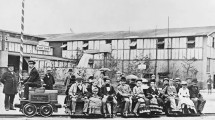Abstract
In this paper, a comprehensive investigation of the capacitive active ripple compensation (ARC) techniques is made to conclude which one is optimal to be used in on-board chargers of electric vehicles. Crucial aspects in such an application are: lifetime, volumetric and specific power density (including components’ size and the needed cooling solution), and overall efficiency of the charger. As presented in this paper, all capacitive ARC topologies (buck, boost, and buck–boost) have successfully diverted the low-frequency ripple from the dc side with a maximized power density. The ARC circuit consists of two additional switches, a smoothing auxiliary inductor, and a storage auxiliary capacitor. Finally, the buck capacitive ARC topology proves to be the optimal ARC technique for on-board chargers because of its maximal power density, minimal loss behavior and voltage stress, and long lifetime capability as it requires a downsized capacitance to the extent, where film capacitors or ceramic capacitors can replace the normally used bulky electrolytic capacitors. The performance of the three capacitive ARC techniques is proved by simulation results.






















Similar content being viewed by others
References
Brown S, Pyke D, Steenhof P (2010) Electric vehicles: the role and importance of standards in an emerging market. Energy Policy 38(7):3797–3806. https://doi.org/10.1016/j.enpol.2010.02.059
Hegazy O, Barrero R, Van Mierlo J, Lataire P, Omar N, Coosemans T (2013) An advanced power electronics interface for electric vehicles applications. IEEE Trans Power Electron 28(12):5508–5521. https://doi.org/10.1109/TPEL.2013.2256469
Kihm A, Trommer S (2014) The new car market for electric vehicles and the potential for fuel substitution. Energy Policy 73:147–157. https://doi.org/10.1016/j.enpol.2014.05.021
Lombardi M, Panerali K, Rousselet S, Scalise J (2018) Electric vehicles for smarter cities: the future of energy and mobility. World Economic Forum. http://www3.weforum.org/docs/WEF_2018_%20Electric_For_Smarter_Cities.pdf
Haghbin S, et al (2010) Integrated chargers for EV’s and PHEV’s: examples and new solutions. In: The XIX international conference on electrical machines—ICEM 2010, Rome, 2010, pp 1–6. https://doi.org/10.1109/ICELMACH.2010.5608152
Yilmaz M, Krein PT (2012) Review of integrated charging methods for plug-in electric and hybrid vehicles. In: 2012 IEEE international conference on vehicular electronics and safety (ICVES 2012), pp 346–351. https://doi.org/10.1109/ICVES.2012.6294276
Fasugba MA, Krein PT (2011) Gaining vehicle-to-grid benefits with unidirectional electric and plug-in hybrid vehicle chargers. In: 2011 IEEE vehicle power and propulsion conference, pp 1–6. https://doi.org/10.1109/VPPC.2011.6043207
Zhou X, Wang G, Lukic S, Bhattacharya S, Huang A (2009) Multi-function bi-directional battery charger for plug-in hybrid electric vehicle application. In: 2009 IEEE energy conversion Congress and exposition, pp 3930–3936. https://doi.org/10.1109/ECCE.2009.5316226
Wen H, Xiao W, Wen X, Armstrong P (2012) Analysis and evaluation of DC-link capacitors for high-power-density electric vehicle drive systems. IEEE Trans Veh Technol 61(7):2950–2964. https://doi.org/10.1109/TVT.2012.2206082
Su M, Pan P, Long X, Sun Y, Yang J (2014) An active power-decoupling method for single-phase AC–DC converters. IEEE Trans Ind Inf 10(1):461–468. https://doi.org/10.1109/TII.2013.2261081
Shimizu T, Jin Y, Kimura G (2000) DC ripple current reduction on a single-phase PWM voltage-source rectifier. IEEE Trans Ind Appl 36(5):1419–1429. https://doi.org/10.1109/28.871292
Yao W, Loh PC, Tang Y, Wang X, Zhang X, Blaabjerg F (2016) Robust power decoupling control scheme for DC side split decoupling capacitor circuit with mismatched capacitance in single phase system. In: IEEE 7th international symposium on power electronics for distributed generation systems (PEDG), Vancouver, pp 1–8. https://doi.org/10.1109/PEDG.2016.7527015
Pan L, Zhang C (2015) A high power density integrated charger for electric vehicles with active ripple compensation. In: Mathematical problems in engineering. https://doi.org/10.1155/2015/918296
Zhong QC, Ming WL, Cao X, Krstic M (2016) Control of ripple eliminators to improve the power quality of DC systems and reduce the usage of electrolytic capacitors. IEEE Access 4:2177–2187. https://doi.org/10.1109/ACCESS.2016.2561269
Cao X, Zhong QC, Ming WL (2015) Ripple eliminator to smooth DC-bus voltage and reduce the total capacitance required. IEEE Trans Ind Electron 62(4):2224–2235. https://doi.org/10.1109/TIE.2014.2353016
Yuan H, Li S, Qi W, Tan S, Hui S (2009) On nonlinear control of single-phase converters with active power decoupling function. IEEE Trans Power Electron 34(6):5903–5915. https://doi.org/10.1109/TPEL.2018.2868506
Author information
Authors and Affiliations
Corresponding author
Additional information
Publisher's Note
Springer Nature remains neutral with regard to jurisdictional claims in published maps and institutional affiliations.
Rights and permissions
About this article
Cite this article
Hammoud, I., Bauer, N., Kallfass, I. et al. Optimized capacitive active ripple compensation topology for a 3.7 kW single-phase high power density on-board charger of electric vehicles. Electr Eng 101, 685–697 (2019). https://doi.org/10.1007/s00202-019-00818-5
Received:
Accepted:
Published:
Issue Date:
DOI: https://doi.org/10.1007/s00202-019-00818-5




